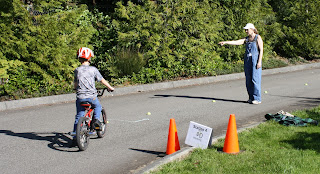 |
| SpokeFest |
I’m writing today not as a volunteer-seeker, regular bicycle commuter, for outreach, as a trainer or organizer, or make-it-happener. Although I’ve worn all of those hats, my time at the Bicycle Alliance of Washington in those roles ends on November 18. Louise asked me to write a short blog about my leaving, and I would like to take a moment of your time to speak from my heart.
What I would like to say, and for you to hear, is: Thank you.
 |
| Tour de Fat |
When I started with the Bicycle Alliance in January, I truly had no idea what I had signed up for (and, it turns out, nobody else knew, either!). Over the next 10 months, I
did all sorts of things: I learned enough about volunteer programs to write a Master’s dissertation on the subject; I helped organize and staffed lots of outreach events; I organized all sorts of other things, from bike classes to a United Way Day of Caring project; I helped the staff start using a more systematic way of bringing new volunteers. I could spend an entire blog post listing the specific events and activities I helped with, and each of those had great value.
Looking back, though, what I take away is far more than the sum of the discrete experiences. Instead, I’ve begun to learn some deeply important lessons that may take a lifetime of reinforcement to truly sink in:
- To keep your responsibilities from overwhelming you, focus on the small things that make up the bigger picture.
- Be persistent. Keep putting one (metaphorical) foot in front of the other even if it feels like you’re not getting anywhere.
- No matter how diligently-planned and meticulously organized an event or program is, things still won’t go the way you want. That’s not only OK, it’s normal and good. Accept that as success.
- Look at problems as opportunities instead of obstacles. Sometimes just changing how you think about a situation can change it from insurmountable to… well… surmountable.
- Every experience is a learning experience, and every experience you learn from is a success.
 |
| Women on Wheels |
You, the loyal, patient, and helpful Bicycle Alliance supporters have taught me this through your commitment and willing support. Thank you from the bottom of my heart. Thank you for these 10 months of learning and growth, 10 months of trying and succeeding, 10 months immersed in bicycling culture. Thank you for welcoming me with open arms, for this opportunity, for the time with you.
Of course, saying all that, I haven’t answered the natural question: What’s next? Although the future looks murky (and really, who can predict their future with any reliability?), I hope to continue my relationship with Bicycle Alliance, albeit in a slightly different capacity: as a bicycle education teacher for several of the big grants that the Bicycle Alliance received in the last few months. So although I won’t have the same 40-hour-a-week presence you’ve become accustomed to, November 18 marks a transition rather than an ending.
See you all out on the road. You'll know me by the reflective helmet streamers.







































